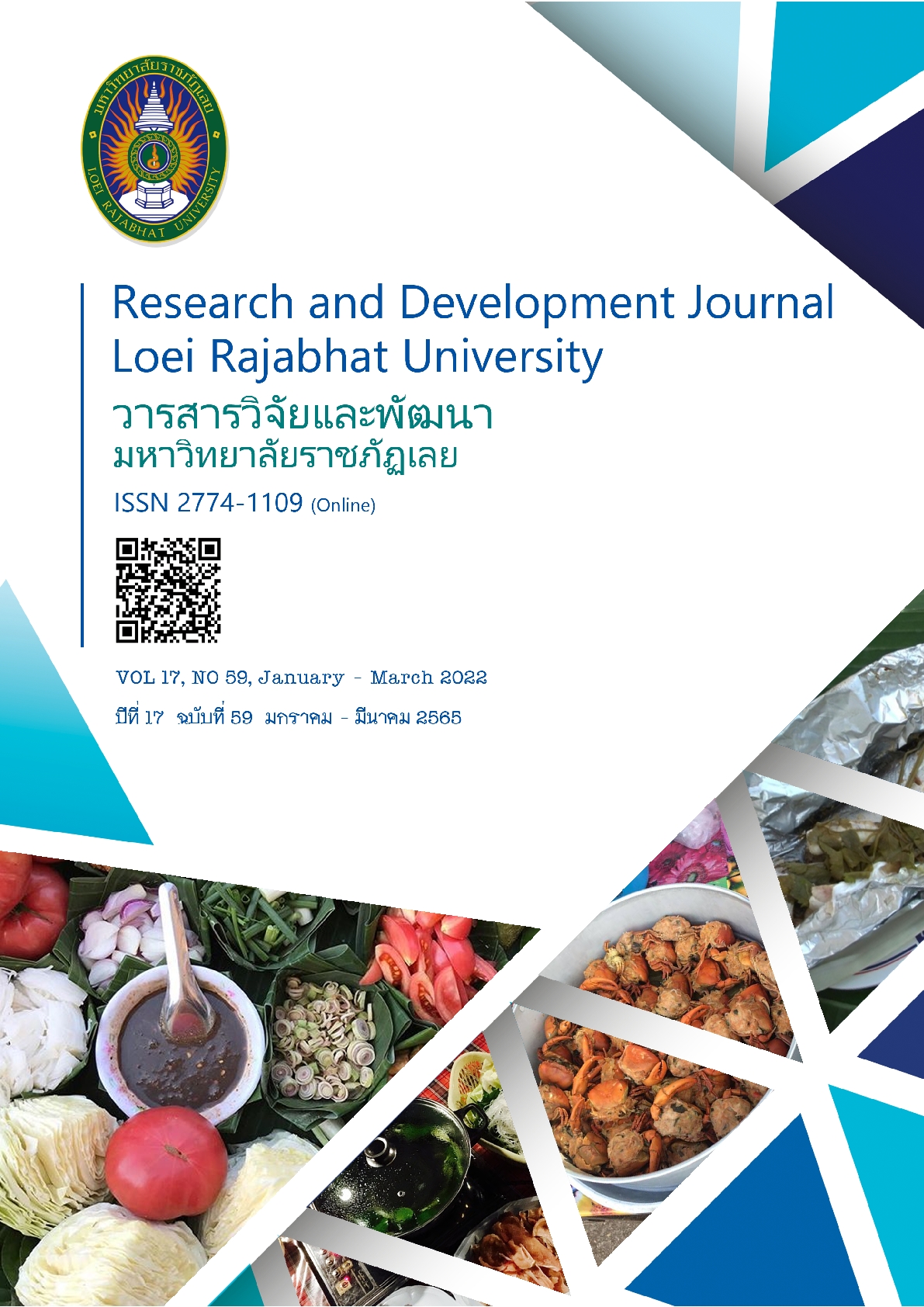The Analysis of Folktales and Folk Media of Loei Province
Keywords:
local literature, folktales, media of Loei province, morality and ethicsAbstract
The research titled “The Analysis of Folktales and Folk Media of Loei Province” was aimed to 1) analyze the folktales and folk media in Loei Province and 2) to analyze the content related to morality and ethnics in folktales and folk media in Loei Province. The data was gathered from related document and field data in 5 districts including Mueang Loei district, Wang Saphung district, Chiang Khan district, Dansai district, and Phuluang district in Loei Province. The population and the target group were 15 subjects who were local philosophers and Buddhist monks. The research tools comprised semi-constructed and unconstructed interviews whereas the data was analyzed using the concepts of folk literature, folk media and morality and ethnics. Descriptive analysis was used to present the research results.
The research results were as follows.
1. There were 63 folktales found in Loei province which were classified into 8 types as follows: 1) miracle tales, 2) life tales, 3) folktales and local legends, 4) explanatory tales, 5) Merry tales 6) animal tales, 7) moral tales and 8) ghost tales and the folk media in Loei Province was classified into 5 types as follows. 1) traditions and ceremonies are Phraya Chang – Nang Phom Hom worshipping tradition, Pha Sad Loi Kror ceremony, Chao Pha Rom Khao Worshipping ceremony, Lord Buddha’s Footprint water sprinkling ceremony on Phra Putthabat Phu Kwain Ngeon temple, Phrathat Si Song Rak Homage-Paying Fair, Phu Ang Lang and Phu Pha Dad worshipping tradition, Phi Ta Khon festival, and Phi Khon Nam tradition. 2) Folk plays are Tai Dam plays such as Mai Jaeng Jae, Siang Tai, Sae Pang, and Maeang Tab Tao Tai-Loei (Morlam Tai-Loei). 3) Costume is Tai-Dam costume. 4) Household appliances and handicrafts were Tum of Tai Dam. And, 5) Mural Arts are mural arts at Mahathat Temple, Tha Kok temple, Si Khun Mueang temple in Chiang Khan district and Phon Chai temple and Neramit Wipassana temple in Dansai Distrcit.
2. Morality and ethnics in folktales can be classified into 14 types including 1) kindness and compassion and do no harm to the others, 2) gratitude and honesty, 3) truthfulness and polite speech, 4) disciplinary 5) sacrifice, charity and sharing, 6) cooperation, 7) effort, endurance and patience, 8) justice, 9) diligence, right means of livelihood and responsibility, 10) greediness, 11) courage and intelligence, 12) householding principles, 13) doing good things, and 14) forgiveness.Morality and ethnics in folk Media can be classified into 5 types as follows. 1) morality in traditions and ceremonies are responsibility, cooperation, sacrifice, honesty, royalty, disciplinary, belief and faith. 2) Morality and ethnics in folk plays are belief and faith and cooperation. 3) Morality and ethics in Tai-Dam costume are diligence, endurance, responsibility, disciplinary, and patience. 4) Morality and ethnics in household appliances and handicrafts are diligence and endurance, responsibility, belief and faith. And, 5) Morality and ethnics in mural arts are the Ten Great Birth Stories of the Buddha (10-virtue practice), Phra Vessantara Jataka (act of generosity) Phra Malai Kam Luang (doing good and bad things).The morality and ethnics in folktales and folk media identify the value for the new generations to conserve, inherit, and transfer to children and youths in Loei province in different forms related to the changing context of the present society.
References
กาญจนา แก้วเทพ. (2544). ศาสาตร์แห่งสื่อและวัฒนธรรมศึกษา. กรุงเทพฯ: เอดิสันเพรสโปรดักส์
กุลธิดา จันทร์เจริญ. (2555). กลวิธีการพัฒนาทรัพยากรมนุษย์ด้วยสื่อพื้นบ้าน: กรณีศึกษาการดำเนินโครงการสื่อพื้นบ้านเพื่อสุขภาวะเยาวชน (วิทยานิพนธ์ ปริญญาดุษฎีบัณฑิต). มหาวิทยาลัยเกษตรศาสตร์, กรุงเทพฯ.
ชม ภูมิภาค. (2520). เอกสารประกอบวิชาเทคโน 521 การบริหารโครงการเทคโนโลยีทางการศึกษา (พิมพ์ครั้งที่ 3). กรุงเทพฯ: มหาวิทยาลัยศรีนครินทรวิโรฒประสานมิตร.
ดนุพล ไชยสินธุ์. (2543). วรรณกรรมจังหวัดเลย. เลย: โรงพิมพ์รุ่งแสงธุรกิจการพิมพ์.
บัวริน วังคีรี. (2551). วรรณกรรมพื้นบ้านในชุมชนลาวหลวงพระบางกับบทบาทการสืบสานความเป็นลาวหลวงพระบางในบริบทสังคมไทย (วิทยานิพนธ์ปริญญาดุษฎีบัณฑิต). จุฬาลงกรณ์มหาวิทยาลัย, กรุงเทพฯ.
พรสวรรค์ ศิริกัญจนาภรณ์. (2562). การบูรณาการวรรณกรรมและสื่อพื้นบ้านเพื่อพัฒนาคุณธรรมจริยธรรมเยาวชนในจังหวัดเลย. เลย: คณะมนุษยศาสตร์และสังคมศาสตร์ มหาวิทยาลัยราชภัฏเลย.
วรพรรณ สุวรรณชื่น. (2550). วิเคราะห์จริยธรรมในนิทานพื้นบ้านจังหวัดอุตรดิตถ์. (การศึกษาค้นคว้าด้วยตนเองปริญญามหาบัณฑิต). มหาวิทยาลัยนเรศวร, พิษณุโลก.
ศาริศา สุขคง. (2555). นิทานพื้นบ้านไทดำบ้านนาป่าหนาด ตำบลเขาแก้ว อำเภอเชียงคาน จังหวัดเลย. เลย: มหาวิทยาลัยราชภัฏเลย.
ศิราพร ณ ถลาง. (2552). ทฤษฎีคติชนวิทยา วิธีวิทยาในการวิเคราะห์ตำนาน-นิทานพื้นบ้าน. กรุงเทพฯ: สำนักพิมพ์แห่งจุฬาลงกรณ์มหาวิทยาลัย.
สาร สาระทัศนานันท์. (2535). นิทานพื้นบ้าน. เลย: ศูนย์ศิลปวัฒนธรรม วิทยาลัยครูเลย.
อุไรวรรณ สิงห์ทอง, หนึ่งฤทัย ม่วงเย็น และ จารุวรรณ แดนนาวาส. (2560). การศึกษาคุณธรรมที่ปรากฏในนิทานพื้นบ้านอีสาน. ใน รายงานสืบเนื่องการประชุมสัมมนาระดับชาติ “พิบูลสงครามวิจัย” ครั้งที่ 3 ประจำปี 2560 Thailand 4.0 นวัตกรรมและการวิจัยเพื่อการพัฒนาอย่างยั่งยืน. หน้า 1-10. 23-24 มีนาคม 2560. พิษณุโลก: มหาวิทยาลัยราชภัฏพิบูลสงคราม.
Downloads
Published
How to Cite
Issue
Section
License
Copyright (c) 2022 Research and Development Journal, Loei Rajabhat University

This work is licensed under a Creative Commons Attribution-NonCommercial-NoDerivatives 4.0 International License.
ข้อความที่ปรากฎในวารสารฉบับนี้เป็นความคิดเห็นของผู้เขียนแต่ละท่าน สถาบันวิจัยและพัฒนา มหาวิทยาลัยราชภัฏเลย และกองบรรณาธิการ ไม่จำเป็นต้องเห็นด้วยและไม่มีส่วนรับผิดชอบใดๆ
สถาบันวิจัยและพัฒนา มหาวิทยาลัยราชภัฏเลย ขอให้ผู้อ่านอ้างอิงในกรณีที่ท่านคัดลอกเนื้อหาบทความในวารสารฉบับนี้



